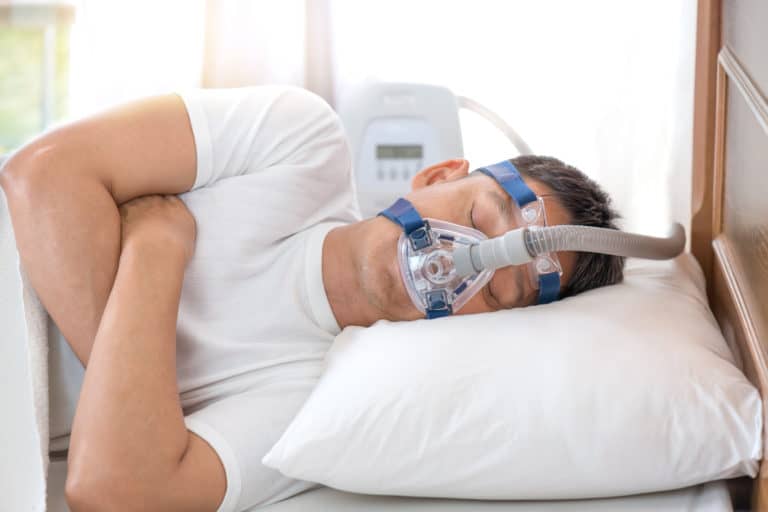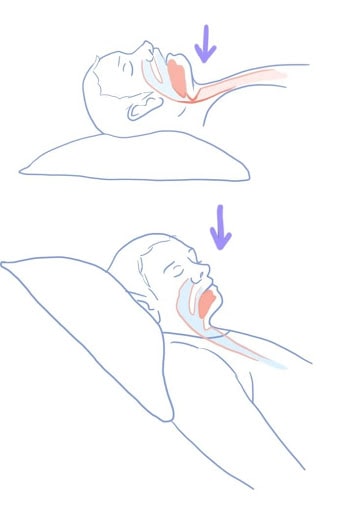What is the best sleeping
position for sleep apnoea?
From broken sleep to a constant feeling of tiredness during the day, sleep apnoea can quickly impact your health and wellbeing. Fortunately, good sleeping posture can help.
What is sleep apnoea?
Sleep apnoea is a condition where your breathing stops for short periods while you sleep. Your brain will wake you up every time your breathing stops in order to restart your breathing. This can happen many times throughout the night, interrupting your sleep and making it difficult for you to get enough oxygen.
You may be completely unaware that this is happening to you during the night, unless your partner comments on your extremely loud snoring! Other symptoms of sleep apnoea include:
- Feeling sleepy in the day
- Feeling irritable
- Concentration and memory problems
- Frequent headaches, especially in the morning
- Being woken by a gasping or choking sensation
These symptoms can be caused by a few different types of sleep apnoea:
Obstructive Sleep Apnoea (OSA)
Obstructive Sleep Apnoea is the most common type of sleep apnoea, caused by your airway being blocked. In OSA, breathing stops for 10 seconds or more, at least 10 times an hour at night.
According to a study from the British Lung Foundation, up to 4% of middle-aged men and 2% of middle-aged women in the UK have OSA. OSA affects an estimated of 1.5 million adults in the UK, and yet up to 85% are undiagnosed, therefore untreated.
For those living with OSA, the muscles that normally hold the airway open in your throat relax too much, allowing your throat to close and block the movement of air. This means sufferers have to work much harder to breathe, causing the loud snoring and following silence that are the hallmarks of OSA.
Central Sleep Apnoea
Much less common than OSA, in Central Sleep Apnoea the brain forgets to signal to the muscles that are involved in breathing. The condition can also be caused by weak breathing muscles.
Mixed Sleep Apnoea
If you suffer from a combination of Obstructive and Central Sleep Apnoea, you may be given a diagnosis of Mixed Sleep Apnoea.
If you think you may have sleep apnoea, it’s vital to speak to your GP. Sleep apnoea is a serious medical condition. It can strain your heart, increase your risk of high blood pressure, an irregular heartbeat, and even a stroke. Your GP may send you for tests to diagnose the problem. They can help you access treatments, like a continuous positive airway pressure (CPAP) therapy, and a CPAP machine to use at night, which will help to keep your airways open while you sleep.
There are also plenty of lifestyle changes you can make to help sleep apnoea at home, that can improve your sleep and health. So, how can you begin to combat sleep apnoea and get a good night’s sleep?
The different sleeping positions
Everyone’s sleep is different. Finding the best sleeping position for you can help you sleep soundly. It can also have profound implications for the severity of sleep apnoea in sufferers. If you’re a sufferer, you’ve probably wondered: what is the best sleeping position for sleep apnoea?
Side sleepers
Snorers everywhere are painfully familiar with the sharp jab of a partner’s elbow in their ribs, demanding that they roll onto their side. It may be no surprise then that sleeping on your side is the best position for sleep apnoea. In fact, researchers have found that side-sleepers experience less frequent and less severe sleep apnoea events.
On top of that, sleeping on your side is . It’s also the most common sleeping position: over 40% of people normally sleep on their side. Make sure that your pillow fills the gap between your shoulder and neck, to keep your spine in a neutral position and help you wake well rested and pain free.

Back sleepers
Sleeping on your back is fairly common: around 18% of sleepers prefer this position. Unfortunately, back sleepers are more likely to snore and also have more severe sleep apnoea, compared to side sleepers. You may have already realised that you only snore when you sleep on your back. One study found that sleep apnoea patients had twice as many apnoea events when sleeping on their back than on their side.
The reason for this may be that during sleep, the lower jaw muscles relax – opening your mouth. This restricts the space available in your throat for air to move through. Laying on your back also allows your tongue, which naturally relax while you’re asleep, to fall backwards and block airflow in and out of your throat.
Front sleepers
Front sleeping is less popular, possibly because this position can strain your neck and back. But if you suffer from sleep apnoea, then front sleeping may be beneficial. Sleeping on your front means that gravity is pulling your relaxed jaw and tongue downwards, away from your airways. However, beware of smothering your face in your pillow in this position – as this can prevent you from breathing easily too.
How does an adjustable bed help sleep apnoea?
Try holding your arms straight out in front of you, so they’re parallel to the floor. You’ll probably notice your muscles have to work hard to keep them there!
Once you relax your arms so they’re hanging by your sides, gravity is pulling your arms into their natural position: at a right angle to the floor. Your muscles don’t have to work anywhere near as hard to keep your arms in this position.
The walls of your throat are naturally at a right angle to the floor too, so when you’re lying in a more upright position, your throat muscles don’t need to work as hard to keep your throat from collapsing. Your tongue won’t be pulled backwards as much, and your relaxed jaw won’t block your airway as it may when lying flat.

How does this actually help with sleep apnoea?
Because of this, sleeping with your head slightly raised significantly improves OSA severity. Blood oxygen saturation and sleep quality are consequently improved in sleep apnoea sufferers when sleeping with your head slightly raised.
While sleeping on your side is best for sleep apnoea on a regular mattress, an adjustable mattress, like those in our range of adjustable beds, makes it easy to sleep with your head above the rest of your body. This means you can sleep on your back if you find this more comfortable, while lying in a position that helps your airways stay open. For obstructive and mixed sleep apnoea sufferers, this is a very effective way to reduce the severity of your condition.
CPAP masks—a common treatment for moderate and severe sleep apnoea—can also be uncomfortable to wear when lying on your side. Buying an adjustable bed can allow you to sleep more comfortably on your back, which means there are more types of CPAP masks that are appropriate for you.
Sleep better and buy our adjustable beds
Ultimately, being able to effectively treat your sleep apnoea will improve your sleep and overall health. Finding the right sleeping position is key to that.
Browse our range of adjustable beds today to discover comfort you control, and stop sleep apnoea ruining your night’s sleep.
If you are ready to buy an adjustable bed but need more information, please don’t hesitate to give us a call on 0800 689 9823 (9am-5pm Mon-Fri), or drop us a message. We can organise a home visit for you to trial any bed, as well as give you professional and reliable advice. Let’s help you get a good nights sleep!


